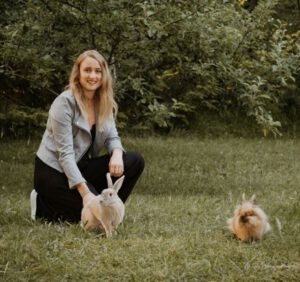Bonding Rabbits with Disabilities or Chronic Illness – or Keeping Them Alone?

Rabbits are social animals and need companions to be truly happy. But what happens when one of your rabbits has a disability or suffers from a chronic illness? These conditions often limit them in certain areas of life, such as eating, moving around, or navigating their environment. This makes social interaction even more important—it gives the sick rabbit strength, emotional support, and makes daily life worth living. That’s why every rabbit with limitations should have at least one companion!
Keeping Rabbits Alone Is Prohibited in Germany
Social animals—of which rabbits are undoubtedly a part—have the innate need to live with companions of their own kind. This need is also recognized and protected by German animal welfare law (§2, Paragraph 1 of the Animal Welfare Act). According to the law, rabbits in Germany must be kept in a way that is appropriate to their species and meets their specific needs.The courts have consistently interpreted this paragraph as a ban on keeping social animals alone (e.g., Administrative Court of Trier, Case No. 6 K 1531/13.TR). Expert committees, which are often consulted by veterinary authorities and courts as professional references, also clearly state that rabbits must not be kept alone due to their social nature.
For example, the Veterinary Association for Animal Welfare (TVT) explicitly recommends keeping rabbits with at least one companion in its guidelines. Therefore, under general animal welfare regulations in Germany, keeping social animals such as rabbits alone is prohibited.
But it’s not always that simple:
How do you go about bonding rabbits when one has a disability or chronic illness? In this article, you’ll learn how to meet that challenge and build a harmonious rabbit group—without overwhelming the rabbit with special needs.
A guide in easy steps
1. Proper Preparation
Before introducing a rabbit with a disability or chronic illness into a group, proper preparation is essential. The rabbit with health limitations should be stable enough to handle the inevitable stress that comes with bonding. Stress can place a heavy burden on sick rabbits and may even worsen their condition.

Consult your rabbit-savvy veterinarian to discuss which medications might be helpful during the bonding process—such as Fenbendazole (Panacur) for rabbits carrying E. cuniculi (EC).
Keep in mind:
The rabbit isn’t aware that a partner is planned for the future. It simply feels lonely every day—and that can take an emotional toll.
We often see that rabbits left alone for more than two weeks start developing one illness after another, which then keeps delaying the bonding process even further. In our experience, these rabbits often don’t survive in the long run. That’s why it’s so important to bond even sick rabbits as soon as possible.
If a recovery is clearly short-term (e.g., a 7-day course of antibiotics), it’s okay to wait. But in cases of recurring illnesses (even if not chronic) or chronic conditions, bonding should still happen as soon as possible—or at least begin with visual contact through a barrier, followed by full bonding after one or two weeks.
2. The Right Companion
When bonding rabbits, especially in a group setting, it’s important to choose a suitable partner for the sick or disabled rabbit.
Rabbits with disabilities are often—though not always—bullied by healthy rabbits, especially if their condition affects their overall well-being. In such cases, it’s often best to house them with other rabbits that also have limitations. Rabbits with mild issues like a chronic sniffle (snuffles) or minor impairments usually get along fine with healthy rabbits. But when it comes to more seriously ill or weakened rabbits, keeping them together tends to work out best—they are usually very gentle, social, and affectionate with one another.

So, try to find a rabbit that also has a disability, ideally with similar limitations and a matching energy level.
For example, a blind or partially paralyzed rabbit should have a companion who is calm and patient—ideally with a similarly quiet temperament. This helps ensure a smooth and low-stress bonding process.
Look for a peaceful, well-socialized rabbit that isn’t aggressive. A very dominant or overly active rabbit could easily overwhelm the one with special needs. Especially if your rabbit suffers from arthritis or has trouble moving, a calm companion is a big advantage.

Young rabbits may initially get along well with a disabled partner—but once puberty hits, this harmony can quickly disappear!
3. The Right Enclosure for Bonding
A neutral space is key to a successful bonding process, especially when bonding rabbits with disabilities.
Adapt the enclosure to meet the needs of the disabled rabbit:
- For rabbits with mobility issues, the enclosure should be barrier-free, making it easier for the rabbit to access all areas. Avoid steep ramps or high edges that are difficult to navigate.
- For rabbits with vision impairments, it’s important to secure the edges and objects with soft padding, such as using crib bumpers tied to the bars of the cage.
Ensure the enclosure is large enough to provide freedom of movement but not too spacious, as the disabled rabbit could easily become overstretched. Typically, two to three square meters is ideal for two rabbits.

4. Patience is Key
Bonding rabbits always requires patience, but when bonding a rabbit with a disability, it’s especially important to give the animals enough time. Observe the behavior of both rabbits closely.
Normally, rabbits with disabilities should be bonded in the same way as other rabbits. However, if they are significantly limited, you can proceed as follows:
Place the enclosures of the two rabbits side by side, allowing visual contact but ensuring they cannot bite each other through the bars. Initially, a larger distance between the enclosures is recommended. Once they are relaxed, interested, and not aggressive at the barrier, you can gradually reduce the distance.
Regularly place the rabbits together for supervised sessions in the neutral enclosure, but keep the encounters short at first, and gradually increase the time. Rushing the process can overwhelm the chronically ill rabbit. Often, they get along right away without fights, especially if they are more severely limited. At that point, they are simply happy to have found each other.
If things go well, you can leave them together permanently in the neutral enclosure for a few days, and then proceed with bonding as you would in a typical scenario.
Experience Report: Bonding with an EC Rabbit
Hoppel had a very severe E. cuniculi (EC) flare-up two weeks after the death of his partner. He had been very attached to her, and the stress from her passing had taken a toll on him, even though it wasn’t obvious from the outside. At the animal shelter, I found Josef, who also had a tilted head due to an ear infection. I was quite nervous about the bonding process, especially since it can be tricky even with healthy rabbits…
When I introduced them, Josef was so happy to have a companion again, and they didn’t fight at all—just a brief scuffle at first. Now, they spend the whole day together, and since Hoppel has had company, it’s been amazing to watch how much better he’s getting every day. Before, his recovery had really stalled.
5. Health Monitoring During the Bonding Process
During the bonding process, it’s crucial to closely monitor the health of your chronically ill or disabled rabbit. Stress can cause the condition of your rabbit to worsen. Watch for signs such as loss of appetite, excessive withdrawal or apathy, or significant weight loss.
6. Creating Positive Experiences
A positive bonding process is supported by shared feedings and relaxed interactions. Offer treats to the rabbits when they behave calmly and make sure that feeding times always occur in the presence of the new companion. This can help create a positive association with the new rabbit and reduce stress. If both rabbits are tame, gently pet them when they sit close to each other (e.g., while eating), as they may think the other rabbit is grooming them. Alternating petting of both rabbits also transfers scent, helping them develop a group scent and feel less like strangers to each other.




















